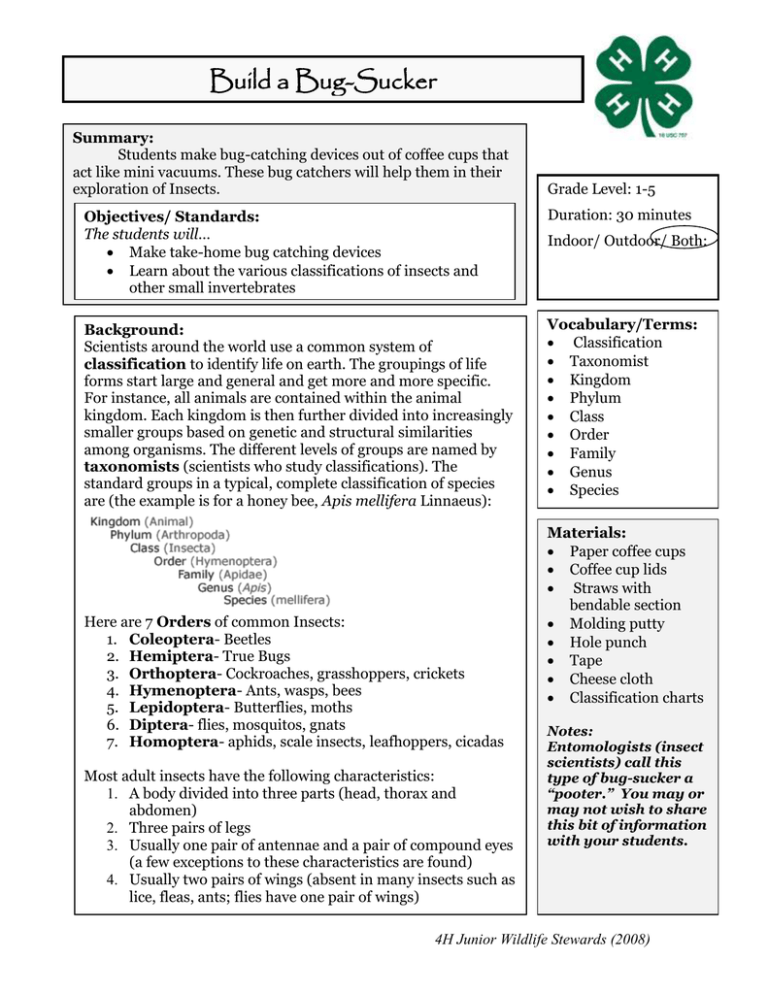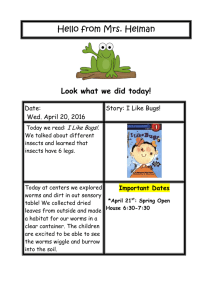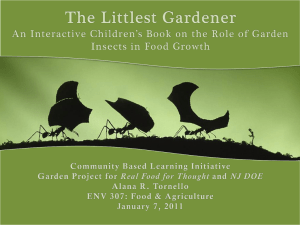Bug Catcher
advertisement

Build a Bug-Sucker Summary: Students make bug-catching devices out of coffee cups that act like mini vacuums. These bug catchers will help them in their exploration of Insects. Grade Level: 1-5 Objectives/ Standards: The students will… Make take-home bug catching devices Learn about the various classifications of insects and other small invertebrates Duration: 30 minutes Background: Scientists around the world use a common system of classification to identify life on earth. The groupings of life forms start large and general and get more and more specific. For instance, all animals are contained within the animal kingdom. Each kingdom is then further divided into increasingly smaller groups based on genetic and structural similarities among organisms. The different levels of groups are named by taxonomists (scientists who study classifications). The standard groups in a typical, complete classification of species are (the example is for a honey bee, Apis mellifera Linnaeus): Vocabulary/Terms: Classification Taxonomist Kingdom Phylum Class Order Family Genus Species Materials: Indoor/ Outdoor/ Both: Here are 7 Orders of common Insects: 1. Coleoptera- Beetles 2. Hemiptera- True Bugs 3. Orthoptera- Cockroaches, grasshoppers, crickets 4. Hymenoptera- Ants, wasps, bees 5. Lepidoptera- Butterflies, moths 6. Diptera- flies, mosquitos, gnats 7. Homoptera- aphids, scale insects, leafhoppers, cicadas Most adult insects have the following characteristics: 1. A body divided into three parts (head, thorax and abdomen) 2. Three pairs of legs 3. Usually one pair of antennae and a pair of compound eyes (a few exceptions to these characteristics are found) 4. Usually two pairs of wings (absent in many insects such as lice, fleas, ants; flies have one pair of wings) Paper coffee cups Coffee cup lids Straws with bendable section Molding putty Hole punch Tape Cheese cloth Classification charts Notes: Entomologists (insect scientists) call this type of bug-sucker a “pooter.” You may or may not wish to share this bit of information with your students. 4H Junior Wildlife Stewards (2008) Essential Questions: How are species classified by scientists? What are the characteristics of true insects? What is a safe way to catch and observe insects without harming them? Set-up: Draw the classification hierarchy of life from Kingdom to Species on the board with a few examples that the students will know and relate to. Procedure: Introduce the idea of Classification to the students. Ask them if they know why lizards are classified as reptiles but humans are classified as mammals? (humans are warm blooded and give birth to live babies, while lizards are cold blooded and usually lay eggs). Show them how taxonomists around the world use the classification system with a few examples from the board. Then tell them that they are going to make bug catchers that allow them to safely catch and observe small bugs without harming them. Notes: The Activity: 1. Give every student a coffee cup, lid, square of cheese cloth, and some molding putty. Have them share straws and hole punches. 2. First punch a hole in the upper portion of the cup with the hole punch. 3. Put the straw through the hole from the outside in, with the shorter section into the cup and the longer section outside. This will be your vacuum hose. 4. Use putty, and tape if necessary, to seal off the space around the straw where it goes through the hole in the cup. This will create better suction and also help to secure the straw to the cup. 5. Put another straw through the mouth opening of the lid and also seal with putty. Tape the cheese cloth to the bottom of this straw. This will serve as a screen to keep bugs that are in the cup from getting sucked up into your mouth. 6. Put the lid on the cup and seal any of the little holes with putty. 7. Check the suction. While holding your finger over the end of the straw, suck through the mouth piece on the lid. If you are getting a lot of air sucking through then there are holes or gaps that can be filled. 8. Test the bug catcher by trying to suck up small bits of paper. 9. Go outside with the Insect classification sheets and look for bugs to catch. You can catch several insects and keep them all in the cup while you suck up more. Take off the lid to examine what you’ve got. 10. Use the insect ID sheets to find out if it’s an insect, and try to classify what order it belongs to! Who are it’s relatives? Notes: If a bug does not fit easily through the straw DO NOT attempt to force it through by sucking extremely hard or with your hands or a stick. Insects are living creatures, be sure to treat them gently, and return them to nature at the end of the lesson. 4H Junior Wildlife Stewards (2008) Wrap-up: Have students share the different bugs that they found, telling about the classification and what other insects are part of its class. Put all bugs back outside relatively close to where you found them. Assessment (how will students demonstrate their understanding?): Have students explain how to use the taxonomist key to classify different forms of life. Students will respectfully capture and observe bugs from the school environment. Extensions A. Have students design their very own insect, based on the characteristics they’ve learned and their own observations. Have them describe where this insect lives and what it eats. B. Find some low-power binocular (dissection) microscopes and have students get a really up-close view of their creatures! 4H Junior Wildlife Stewards (2008)



